初中疑问句、祈使句、感叹句
- 格式:pdf
- 大小:17.51 KB
- 文档页数:7

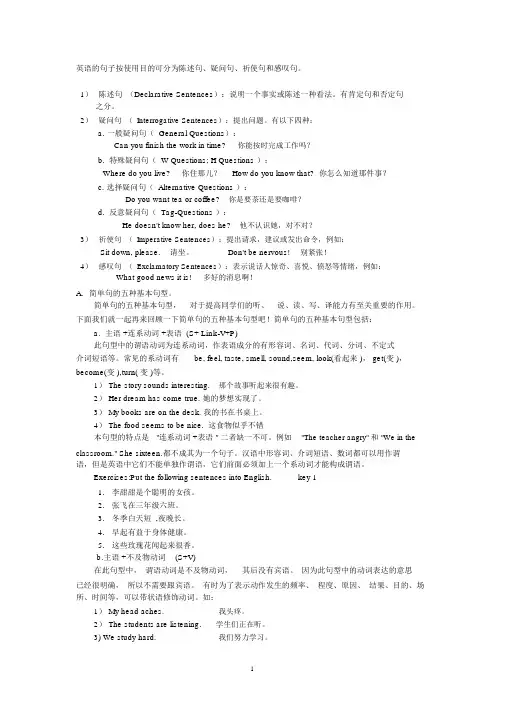
英语的句子按使用目的可分为陈述句、疑问句、祈使句和感叹句。
1)陈述句(Declarative Sentences):说明一个事实或陈述一种看法。
有肯定句和否定句之分。
2)疑问句(Interrogative Sentences):提出问题。
有以下四种:a. 一般疑问句( General Questions):Can you finish the work in time?你能按时完成工作吗?b. 特殊疑问句( W Questions; H Questions ):Where do you live?你住那儿?How do you know that? 你怎么知道那件事?c. 选择疑问句( Alternative Questions ):Do you want tea or coffee?你是要茶还是要咖啡?d. 反意疑问句( Tag-Questions ):He doesn't know her, does he?他不认识她,对不对?3)祈使句(Imperative Sentences):提出请求,建议或发出命令,例如:Sit down, please.请坐。
Don't be nervous!别紧张!4)感叹句(Exclamatory Sentences):表示说话人惊奇、喜悦、愤怒等情绪,例如:What good news it is!多好的消息啊!A.简单句的五种基本句型。
简单句的五种基本句型,对于提高同学们的听、说、读、写、译能力有至关重要的作用。
下面我们就一起再来回顾一下简单句的五种基本句型吧!简单句的五种基本句型包括:a.主语 +连系动词 +表语 (S+ Link-V+P)此句型中的谓语动词为连系动词,作表语成分的有形容词、名词、代词、分词、不定式介词短语等。
常见的系动词有be, feel, taste, smell, sound,seem, look(看起来 ), get(变 ),become(变 ),turn( 变 )等。
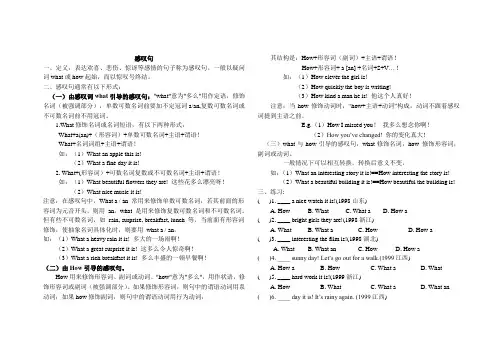
感叹句一、定义:表达欢喜、悲伤、惊讶等感情的句子称为感叹句。
一般以疑问词what或how起始,而以惊叹号终结。
二、感叹句通常有以下形式:(一)由感叹词what引导的感叹句:"what"意为"多么"用作定语,修饰名词(被强调部分),单数可数名词前要加不定冠词a/an,复数可数名词或不可数名词前不用冠词。
1.What修饰名词或名词短语,有以下两种形式:What+a(an)+(形容词)+单数可数名词+主语+谓语!What+名词词组+主语+谓语!如:(1)What an apple this is!(2)What a fine day it is!2. What+(形容词)+可数名词复数或不可数名词+主语+谓语!如:(1)What beautiful flowers they are! 这些花多么漂亮呀!(2)What nice music it is!注意:在感叹句中,What a / an 常用来修饰单数可数名词,若其前面的形容词为元音开头,则用an。
what 是用来修饰复数可数名词和不可数名词。
但有些不可数名词,如rain, surprise, breakfast, lunch 等,当前面有形容词修饰,使抽象名词具体化时,则要用what a / an,如:(1)What a heavy rain it is! 多大的一场雨啊!(2)What a great surprise it is! 这多么令人惊奇啊!(3)What a rich breakfast it is! 多么丰盛的一顿早餐啊!(二)由How引导的感叹句。
How用来修饰形容词、副词或动词。
"how"意为"多么",用作状语,修饰形容词或副词(被强调部分)。
如果修饰形容词,则句中的谓语动词用系动词;如果how修饰副词,则句中的谓语动词用行为动词,其结构是:How+形容词(副词)+主语+谓语!How+形容词+ a [an] +名词+S+V… !如:(1)How clever the girl is!(2)How quickly the boy is writing!(3)How kind a man he is! 他这个人真好!注意:当how修饰动词时,“how+主语+动词”构成,动词不跟着感叹词提到主语之前。
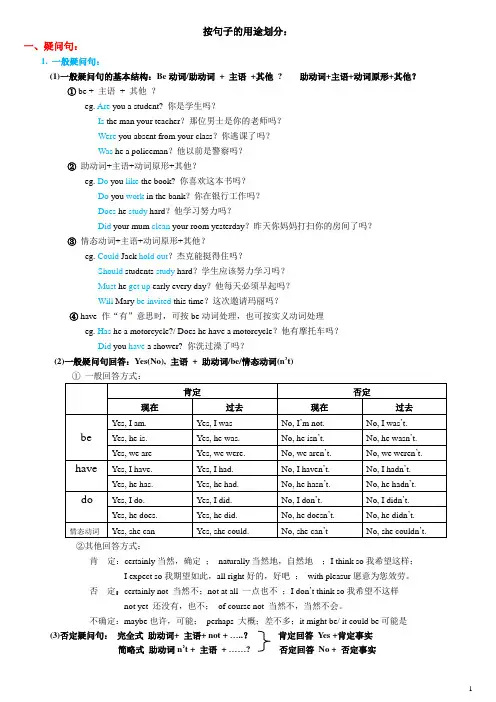
按句子的用途划分:一、疑问句:1. 一般疑问句:(1)一般疑问句的基本结构:Be动词/助动词+ 主语+其他? 助动词+主语+动词原形+其他?①be + 主语+ 其他?eg. Are you a student? 你是学生吗?Is the man your teacher?那位男士是你的老师吗?Were you absent from your class?你逃课了吗?Was he a policeman?他以前是警察吗?②助动词+主语+动词原形+其他?eg. Do you like the book? 你喜欢这本书吗?Do you work in the bank?你在银行工作吗?Does he study hard?他学习努力吗?Did your mum clean your room yesterday?昨天你妈妈打扫你的房间了吗?③情态动词+主语+动词原形+其他?eg. Could Jack hold out?杰克能挺得住吗?Should students study hard?学生应该努力学习吗?Must he get up early every day?他每天必须早起吗?Will Mary be invited this time?这次邀请玛丽吗?④have 作“有”意思时,可按be动词处理,也可按实义动词处理eg. Has he a motorcycle?/ Does he have a motorcycle?他有摩托车吗?Did you have a shower? 你洗过澡了吗?(2)一般疑问句回答:Yes(No), 主语+ 助动词/be/情态动词(n’t)②其他回答方式:肯定:certainly当然,确定;naturally当然地,自然地;I think so我希望这样;I expect so我期望如此,all right好的,好吧;with pleasur愿意为您效劳。
否定:certainly not 当然不;not at all 一点也不;I don’t think so我希望不这样not yet 还没有,也不;of course not 当然不,当然不会。

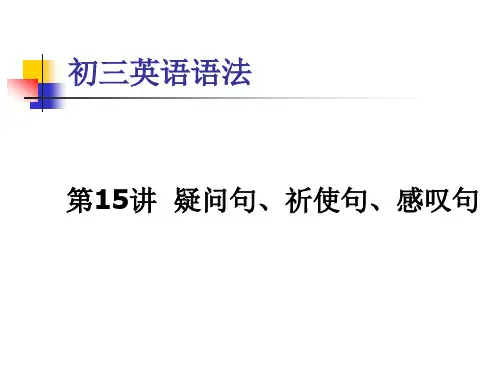
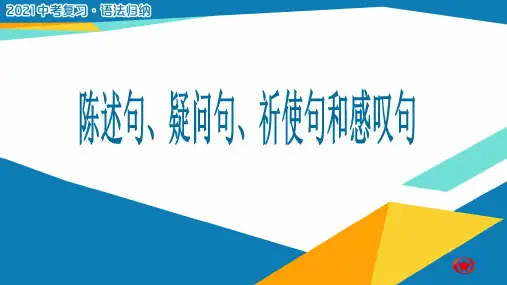
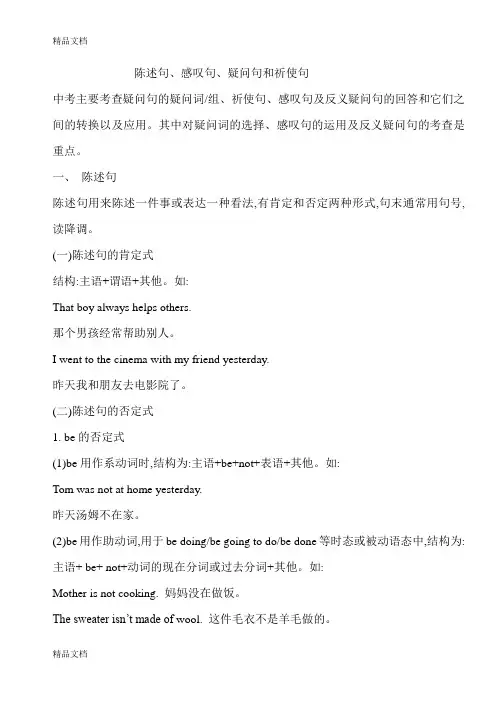
陈述句、感叹句、疑问句和祈使句中考主要考查疑问句的疑问词/组、祈使句、感叹句及反义疑问句的回答和它们之间的转换以及应用。
其中对疑问词的选择、感叹句的运用及反义疑问句的考查是重点。
一、陈述句陈述句用来陈述一件事或表达一种看法,有肯定和否定两种形式,句末通常用句号,读降调。
(一)陈述句的肯定式结构:主语+谓语+其他。
如:That boy always helps others.那个男孩经常帮助别人。
I went to the cinema with my friend yesterday.昨天我和朋友去电影院了。
(二)陈述句的否定式1. be的否定式(1)be用作系动词时,结构为:主语+be+not+表语+其他。
如:Tom was not at home yesterday.昨天汤姆不在家。
(2)be用作助动词,用于be doing/be going to do/be done等时态或被动语态中,结构为:主语+ be+ not+动词的现在分词或过去分词+其他。
如:Mother is not cooking. 妈妈没在做饭。
The sweater isn’t made of wool. 这件毛衣不是羊毛做的。
2. 助动词、情态动词的否定式The girl doesn’t do housework at home.这个女孩在家不做家务。
Man can’t live without water.没有水人类不能生存。
3. 除not外,其他否定词也可以构成否定句(1)用no表示,no=not any/a。
如:He has no child.=He doesn’t have any children.他没有孩子。
(2)never绝不,从来不。
如:I have never seen such a strange man.我从没见过这样奇怪的人。
(3)little, few几乎没有。
如:There are few students in the crowd.人群里几乎没有学生。
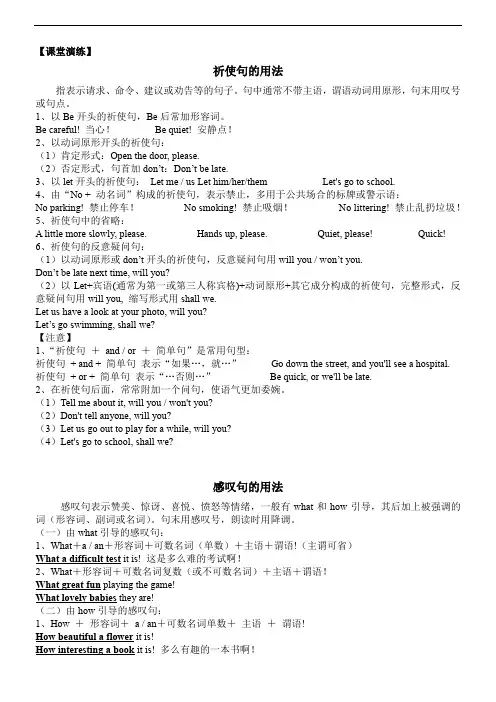
【课堂演练】祈使句的用法指表示请求、命令、建议或劝告等的句子。
句中通常不带主语,谓语动词用原形,句末用叹号或句点。
1、以Be开头的祈使句,Be后常加形容词。
Be careful! 当心!Be quiet! 安静点!2、以动词原形开头的祈使句:(1)肯定形式:Open the door, please.(2)否定形式,句首加don’t:Don’t be late.3、以let开头的祈使句:Let me/us Let him/her/them Let's go to school.4、由“No + 动名词”构成的祈使句,表示禁止,多用于公共场合的标牌或警示语:No parking! 禁止停车!No smoking! 禁止吸烟!No littering! 禁止乱扔垃圾!5、祈使句中的省略:A little more slowly, please. Hands up, please.Quiet, please! Quick!6、祈使句的反意疑问句:(1)以动词原形或don’t开头的祈使句,反意疑问句用will you / won’t you.Don’t be late next time, will you?(2)以Let+宾语(通常为第一或第三人称宾格)+动词原形+其它成分构成的祈使句,完整形式,反意疑问句用will you, 缩写形式用shall we.Let us have a look at your photo, will you?Let’s go swimming, shall we?【注意】1、“祈使句+and/or +简单句”是常用句型:祈使句+ and + 简单句表示“如果…,就…”Go down the street,and you'll see a hospital.祈使句+ or + 简单句表示“…否则…”Be quick,or we'll be late.2、在祈使句后面,常常附加一个问句,使语气更加委婉。
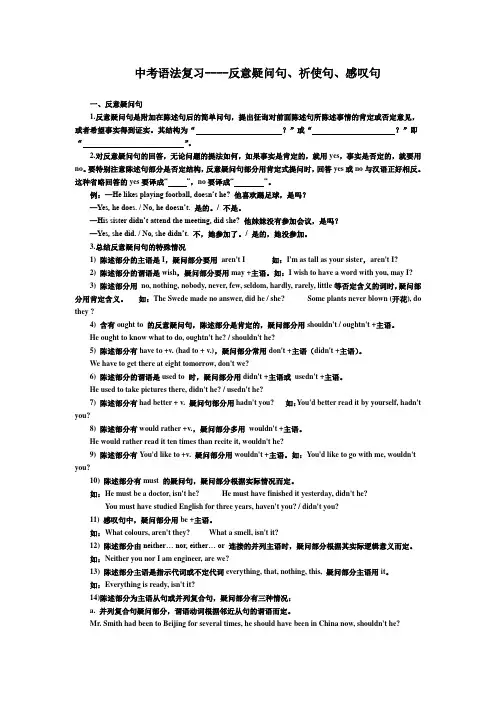
中考语法复习----反意疑问句、祈使句、感叹句一、反意疑问句1.反意疑问句是附加在陈述句后的简单问句,提出征询对前面陈述句所陈述事情的肯定或否定意见,或者希望事实得到证实。
其结构为“?”或“?”即“”。
2.对反意疑问句的回答,无论问题的提法如何,如果事实是肯定的,就用yes,事实是否定的,就要用no。
要特别注意陈述句部分是否定结构,反意疑问句部分用肯定式提问时,回答yes或no与汉语正好相反。
这种省略回答的yes要译成“”,no要译成“”。
例:—He likes playing football, doesn’t he? 他喜欢踢足球,是吗?—Yes, he does. / No, he doesn’t. 是的。
/ 不是。
—His sister didn’t attend the meeting, did she? 他妹妹没有参加会议,是吗?—Yes, she did. / No, she didn’t. 不,她参加了。
/ 是的,她没参加。
3.总结反意疑问句的特殊情况1) 陈述部分的主语是I,疑问部分要用aren't I 如:I'm as tall as your sister,aren't I?2) 陈述部分的谓语是wish,疑问部分要用may +主语。
如:I wish to have a word with you, may I?3) 陈述部分用no, nothing, nobody, never, few, seldom, hardly, rarely, little等否定含义的词时,疑问部分用肯定含义。
如:The Swede made no answer, did he / she? Some plants never blown (开花), do they ?4) 含有ought to 的反意疑问句,陈述部分是肯定的,疑问部分用shouldn't / oughtn't +主语。
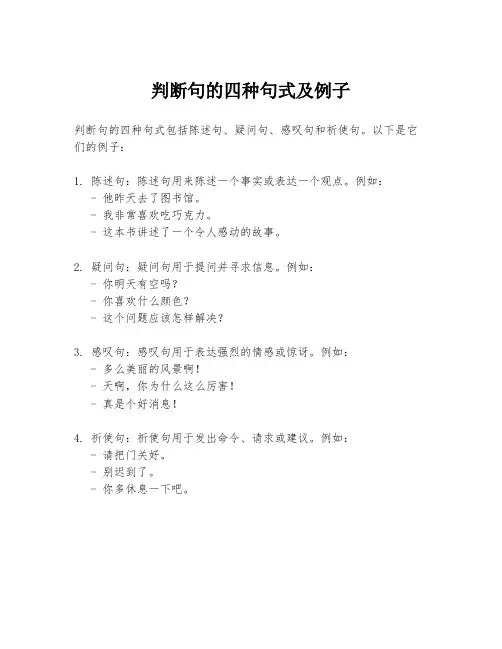
判断句的四种句式及例子
判断句的四种句式包括陈述句、疑问句、感叹句和祈使句。
以下是它们的例子:
1. 陈述句:陈述句用来陈述一个事实或表达一个观点。
例如:
- 他昨天去了图书馆。
- 我非常喜欢吃巧克力。
- 这本书讲述了一个令人感动的故事。
2. 疑问句:疑问句用于提问并寻求信息。
例如:
- 你明天有空吗?
- 你喜欢什么颜色?
- 这个问题应该怎样解决?
3. 感叹句:感叹句用于表达强烈的情感或惊讶。
例如:
- 多么美丽的风景啊!
- 天啊,你为什么这么厉害!
- 真是个好消息!
4. 祈使句:祈使句用于发出命令、请求或建议。
例如:
- 请把门关好。
- 别迟到了。
- 你多休息一下吧。
初中英语知识点汇总:陈述句、疑问句、祈使句、感叹句句子的类型(一)教学重点句子的类型:陈述句陈述句(包括肯定的或否定的)用来叙述一项事实。
陈述句的结构分为肯定结构和否定结构两种。
1、陈述句的肯定结构(1)主语与谓语的一致,句子中的谓语动词和主语在人称和数上必须一致。
如:I was having dinner when he came in.He is now working at a bank.①谓语只跟主语的中心词保持一致,修饰词不影响主语的数:The quality of this kind of bike is poor.There be结构和其他倒装句中,谓语通常放在主语的前面,这时谓语是单数还是复数,要依后面的主语而定,如:There is no milk in the bottle.There are no students iin the classroom.②“one of ……”结构作主语,谓语应该用单数。
如:One of the students is absent.Making things is a good activity.What hurt her most is his words.③由and连接两个或两个以上的名词,由“both…and…”连接的两个成分作主语,其谓语动词通常用复数形式,如:Susan and Sally like pop music.The worker and the peasant are going to give us a talk.④单数名词后面有下面词语修饰时,主语不受这些词或词组的影响with…. like…as well as…together with…He, as well as his classmates, likes popular songs.Mr Li, together with his wife and two songs, is on holiday these days.⑤由连词“either…or…”,“neither…nor…”,“not only…but also…”,also, nor, or连接两个名词或代词,谓语动词的形式应与最近的主语保持一致Neither I nor my brother is good at maths.Either you or I’m wrong.注意:表示数量、时间、距离、金钱等的复数名词作主语时,谓语动词一般用单数形式。
中考英语语法祈使句感叹句反意疑问句(名师总结)中考英语语法祈使句、感叹句、反意疑问句(名师总结)名师讲义内部讲义,应该浏览自学!乏味英语语法用图表展现,学生们通俗易懂!中考英语语法:祈使句、感叹句、反意疑问句主谓一致单主对单谓语法一致原则单名单代不定式动名词+单复数名词或代词并作主语+为丛藓科扭口藓and,both...and...作主语+为丛藓科扭口藓morethanone/manya+单名+单意义一致原则复主对复谓就近一致原则and相连接的主语指同一人/物+单oreither...orneither...nornotonly...butalso时间、距离、金钱无论单复一律+单复形单意news,physics,maths,politics+单单形复意people,police+为丛藓科扭口藓with,but,except,besides,like不算数glasses,trousers,pants,gloves,shoes,scissors+复,pair决定anumberof+复名+复class,family,group,team,chinese,japanese整+单;个+为丛藓科扭口藓not...butall,some,any,half,enough,most,therest,(百)分数由名词定数therebe“the+形容词”表“一类人”+复thenumberof+复名+单”表中“夫妇/一“the+姓氏复数家”+复population+单,但粱分数+为丛藓科扭口藓each或复合不定代词+单oneof,eachof,noneof,eitherof,neitherof+单先行词作主语,同意的定从谓动单复数第1页共1页相信天道酬勤,学会笨鸟先飞!名师讲义内部讲义,值得下载学习!枯燥英语语法用图表展示,学生们通俗易懂! yaku表中命令/命令/建议等谓动用原形且常省主语若提人称,“,”分隔分类v原结尾考点答语反意疑问句please结尾中考避免连词成句用逗号ok,iwill.通常后加willyou?let结尾sorry,iwon’t.let’s...,shallwe?don’t开头letme/us/sb..,willyou?no+名词/动名词never+动原let’s/me+not+动原don’tlet+第三人称+动原第2页共2页相信天道酬勤,学会笨鸟先飞!名师讲义内部讲义,值得下载学习!枯燥英语语法用图表展示,学生们通俗易懂!感叹句what+a+可单+主+谓+其它!what+形+不可数+主+曰+其它!how+形+a/an+可单+主+谓+其它!表中赞美、赞叹、欢欣、等感情解题步骤what+a+形+肺痈+主+曰+其它!从后往前删帖主谓,参考所余最后一个词 what+an+形+可单+主+谓+其它!是名词就用what;否则用howwhat+形+复数+主+曰+其它!若用what,加不加a,取决于名词若用a,加不加an取决于形容词how+形+主+曰+其它!how+副+主+谓+其它!how+主+曰+其它!第3页共3页相信天道酬勤,学会笨鸟先飞!名师讲义内部讲义,值得下载学习!枯燥英语语法用图表展示,学生们通俗易懂!偏齿疑问句前后恰好相反时态一致人称替代前肯后指为,前否后特雷隆与前半句适当的助动、be颤抖和情态动词必须用人表示代词never,seldom,little,few,hardly也表中驳斥’s(1)is(2)has’d(1)would(2)hadiam…,aren’ti?somethingis…,isn’tit?驳斥后缀,算不上驳斥have在前句中就是v实还是v并助,看看其后存有donesomebodyis…,isn’the?/aren’tthey?too...to...算是驳斥,so...that.算是确实therebe….,bethere?therewillbe…,won’tthere?注意事项含有推测的句子think答语先回去推断(不回去not),再搞偏齿疑问句ithink...偏齿疑问句以从句为依据,主句的驳斥归属于从句;其它人think反之原则:实话实说:上句译作为“与否”,下句此事与否有误。
句子的种类英语句子按照使用目的和交际功能,可分为四大类陈述句、疑问句、祈使句和感叹句.一.陈述句1、陈述句:说明一个事实或陈述一个看法,有肯定式和否定式,语序是主语在前,谓语在后。
2.掌握陈述句的肯定式和否定式的构成及用法。
e。
g。
We live in Tianjin。
(肯定句)我们住在天津。
We don’t live in Shanghai。
(否定句)我们不住在上海。
注意:(1)在一般现在时的肯定式中,主语是第三人称单数时,动词要改成第三人称单数形式.e.g。
John studies Chinese very well。
(2)若句中有be动词、情态动词或助动词,则分别在他们的后面加not.Sometimes you're supposed to come early. (变为否定句)(3)若句中有be动词、情态动词或助动词,要在行为动词(实义动词)前面加助动词do/does,did等与not的缩写形式,并注意这使得行为动词要用原型。
另外,还需将原句中some变成any,too改为either,already改为yet。
e。
g。
I don't like swimming. 我不喜欢游泳。
He doesn’t have lunch at home every day。
他每天不在家吃午饭。
They didn’t play football yesterday。
他们昨天没有踢足球.He did some work this morning。
(改为否定句)He didn't do any work this morning。
二.疑问句疑问句用来提出问题,句末用问号“?”。
常见的疑问句有:一般疑问句、特殊疑问句、选择疑问句和反意疑问句。
(一)一般疑问句:1.用来询问一件事,答案通常是yes或no,注意语序。
e。
g。
Do you often speak English at school ? 在学校你常讲英语吗?Yes, I do. /No,I don’t。
(1)疑问句:用来提出疑问的句子。
可以分为:一般疑问句、特殊疑问句、选择疑问句和反意疑问句四种类型。
1)一般疑问句:能够用Yes或者No来回答的疑问句叫一般疑问句。
肯定回答用Yes,否定回答用No。
一般疑问句的结构是:Be+主语+表语+……?或者是:助动词/情态动词+主语+谓语+……?例如:-Are you a teacher? 你是老师吗?-Yes, I am. 是的,我是。
或:-No, I am not. 不,我不是。
—Does your mother go shopping on Sunday? 你妈妈星期天购物吗?-Yes, she does. 是的,她经常去购物。
不,她不经常去购物。
或:-No, she doesn’t.—Must we go at once? 我们必须立刻走吗?—Yes, we must. 是的,必须走。
或:—No, we needn’t. 不,没有必要。
注意:一般疑问句也可用表示肯定或否定的词来回答,如certainly(当然),surely(当然),of course(当然),I think so(我想是的),all right(好吧),certainly not(当然不是), not at all(一点也不), never(从不),sorry(很抱歉),not yet(还没有) I’m afraid not(恐怕不是)等。
2) 特殊疑问句:用来对句子的某一特殊部分提问的句子叫特殊疑问句。
特殊疑问句一般用降调。
其结构是:特殊疑问词+一般疑问句(+……)?对它的回答不能用Yes或者No,要根据询问的内容具体回答。
例如:-Where were you at that time? 那时你在哪里?—I was at home. 我在家。
常用的疑问代词有who(谁),whom(谁),whose(谁的),which(哪一个),what(什么);疑问副词有when(何时),where(何地),why(为什么),how(如何)以及“how+形容词”构成的短语。
例如:Who is your teacher? 谁是你的老师?(指人,作主语)Whom did you telephone to just now? 你刚才给谁打电话?(指人,作宾语)Whose coat is this? 这是谁的大衣?(作定语)Which child knows the answer? 哪个孩子知道答案?(作定语)What class are you in? 你在几班?(指物,作定语)When will you arrive?(提问时间)Where has he gone?(提问地点)Why are you late again?(提问原因)How do you often go to school? (提问方式)How far is it from your house to your school? (how far 提问距离)How often does he go to the French club? (how often 提问频率)3)选择疑问句:选择疑问句是提供两种或者两种以上的情况,问对方选择哪一种。
其结构可以用一般疑问句也可以用特殊疑问句,之间用连词or链接。
选择疑问句不能用yes或者no来回答,必须选择其中之一来回答。
例如:—Shall we go there by bus or on foot? 我们乘坐公共汽车去还是步行去?—We’ll go by bus. 我们乘坐公共汽车去。
—Which do you like better, tea or coffee? 茶和咖啡,你更喜欢哪种?—I like tea better. 我更喜欢茶。
4) 反意疑问句:也叫附加疑问句,是在陈述句的后面加一个简短问句,对陈述句所说的事实或者观点提出疑问或希望陈述句部分内容得到证实。
结构为“肯定陈述句+否定问句+?”或“否定陈述句+肯定问句+?”。
例如:你会来的,是吗?You are coming, aren’t you?You can’t swim, can you? 你不会游泳,对吗?她哥哥去年上的大学,是不是?Her brother went to college last year, didn’t he?注意:①陈述部分的主句带有no, never, nothing, nowhere, hardly, seldom, few, little等否定词或半否定词时,附加问句用肯定形式。
例如:You hardly speak English, do you? 你几乎不能说英语,对吗?They have few friends here, do they? 他们在这里几乎没有朋友,对吗?①There be句型的反意疑问句,其附加问句仍用there。
明天有个晚会,是不是?There will be a party tomorrow, won’t there?①陈述部分是一个主从复合句,附加问句一般要和主句一致。
但是当陈述部分是“I’m sure…, I’m afraid…, I (don’t) think / believe… +宾语从句”结构时,附加问句应与从句一致,而且要注意否定转移现象。
他说他上课迟到了,是吗?He said he was late for class, didn’t he?I don’t think he is good at math, is he? 我认为他不擅长数学,是不是这样?(否定转移)①反意疑问句的答语一般要根据事实用yes或no引导的简单问句回答,汉语的翻译有时和英语不一致。
例如:—She can’t swim, can she?她不会游泳,对吗?—Yes, she can. 不,她会。
你昨天没有在这里,对吗?—You weren’t here yesterday, are you?是,我不在。
—No, I wasn’t.(2)祈使句:祈使句是用来表示请求、命令、劝告、建议等语气的句子。
祈使句的主语一般是第二人称+动词原形+其他。
you,但往往省略,谓语一般用动词原形,否定句是用助动词don’t例如:Don’t be late next time. 下一次不要迟到。
Open the door, please. 请打开门。
有时候祈使句的后面用附加疑问句加强语气。
例如:Don’t tell it anyone, will you? 不要告诉任何人,好吗?(3)感叹句:表示喜怒哀乐等强烈感情的句子叫感叹句。
感叹句的末尾用感叹号。
句子开头经常用what 或者how。
1)How在感叹句中可以修饰形容词、副词、或整个句子等。
例如:How beautiful the skirt is! 这条裙子多漂亮呀!How tall your brother is!你的哥哥多高呀!How time flies! 时间过得真快呀!2)what在感叹句可以修饰名词。
如果名词是可数名词的单数形式,用what+a/an+(形容词)+名词+主语+谓语!如果是不可数名词或者可数名词的复数形式用What+(形容词)+名词+主语+谓语!例如:What a tall boy your brother is! 你哥哥是一个多么高的男孩!What beautiful pictures they are! 那些图画多美丽呀!注意:what和how引导的感叹句有时可以互换,但是要注意词序的变化。
例如:他是多聪明的孩子!What a clever boy he is! = How clever a boy he is!= How clever the boy is!I.单项选择。
1.—________ do you make a banana milk shake?—Peel the banana first and blend it with milk.A.What B.When C.How D.Where2.There are two libraries in this city,________?A.aren’t there B.aren’t they C.isn’t it D. is it,does she?3.—She doesn’t like geography—________.A.Yes,she does B.Yes,she doesn’t C.No,she does D. Yes,she is 4.________ information he offered us! We all thank him.A.What useful B.What useless C.How useful D.How useless 5.John,clean your room,________?A.will you B.shall we C.don’t you D.doesn’t he6.—________ won the 100th gold medal at the Olympics for China?—Zhang Yining.She’s from Beijing.A.Who B.What C.When D.Where7.Our hometown is more beautiful than before.________?A.isn’t it B.is it C.doesn’t it D.does it8.— ________ will the foreign students be back from Xibaipo?—In five days.A.How soon B.How often C.Flow far D.How fast9. ________ weather it is!A. What a fineB. How fineC. What fineD. How fine the10. -_______ day it is!-Let’s go out and have a picnic.A. How coldB. How niceC. What a cloudyD. What a lovely11. I suppose you are not going today, _________?A. are youB. do youC. don’t youD. aren’t you12.-Don’t you often go shopping?-_________. I work very late every day.A. Yes, I doB. No, I don’tC. Yes, I don’tD. No, I do13.-Linda had nothing for breakfast this morning , ________?-No, she got up too late.A. had sheB. hadn’t sheC. did sheD. didn’t she14.-_______ is that man over there?-That’s my brother.A. WhoB. WhatC. WhereD. How15.-______ did you have the party last night?-In the park.A. WhatB. WhyC. WhenD. Where16._______ sleep too late. It’s bad for your health.A. DoB. NotC. Don’tD. Isn’t17.________, and you will do well in physics.A. StudyingB. Study hardC. Studies hardD. To study hard18.You bought a new computer last week, ______?A. aren’t youB. don’t youC. didn’t youD. haven’t you19. _______ it’s blowing outside!A. What heavyB. How heavyC. How heavilyD. What heavily20. ________ Mrs. Smith is!A. How kind womanB. What a kind womanC. What kind womanD. How a kind womanII. 按括号内要求完成下列句式。